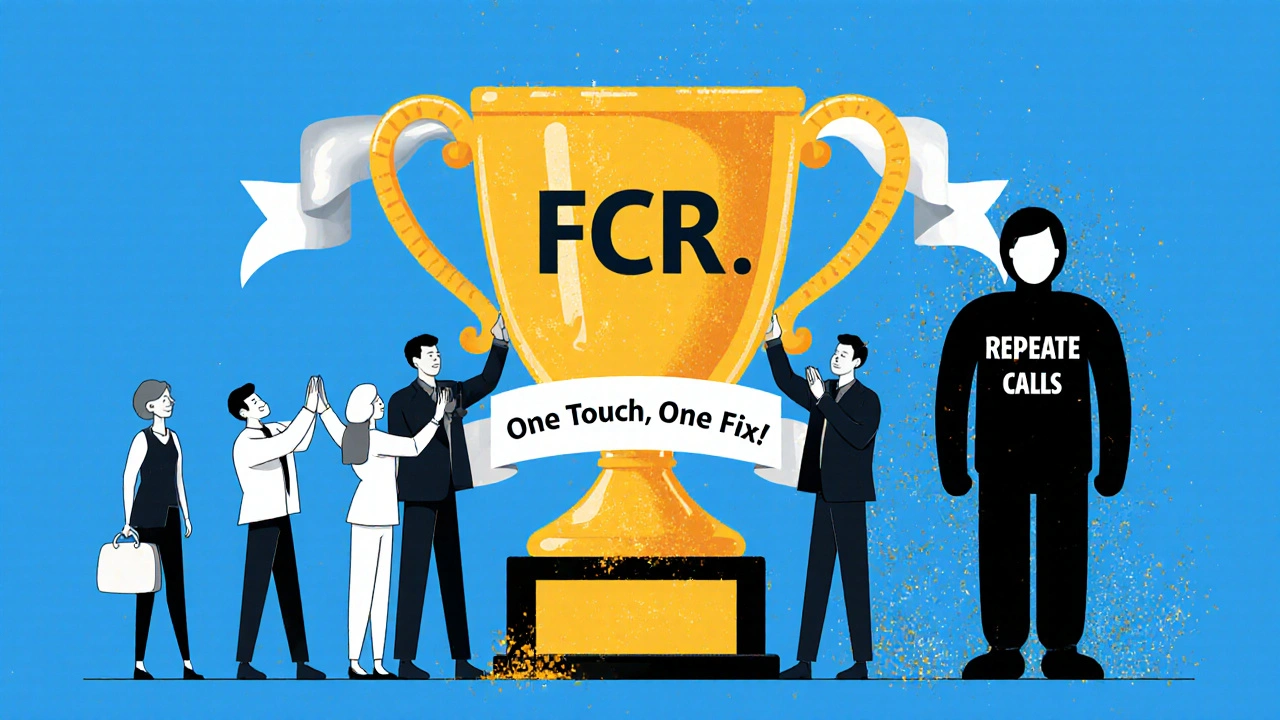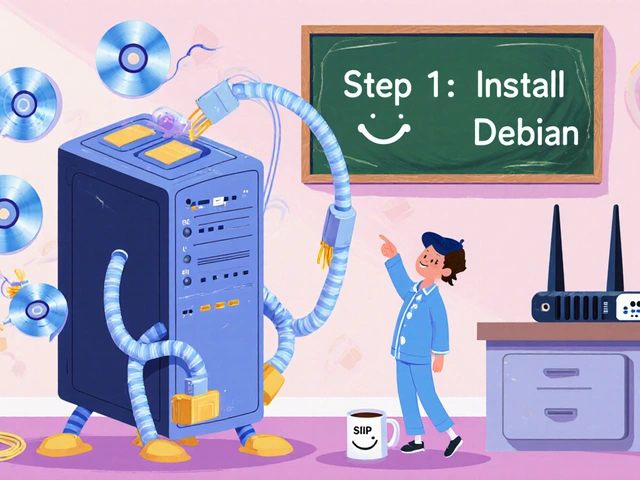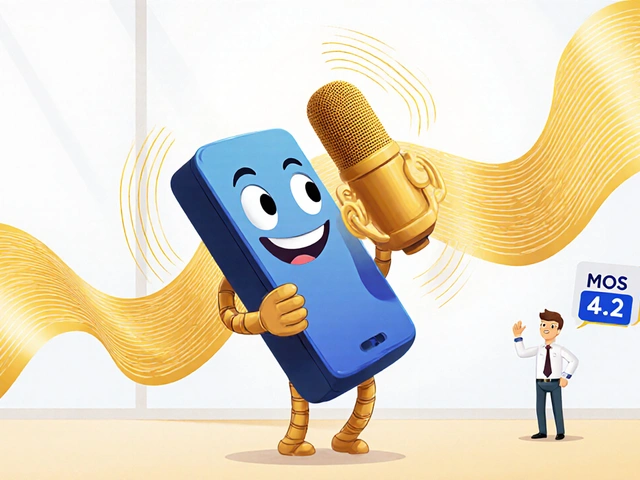Imagine calling your internet provider because your service went out. You explain the problem, wait on hold, and finally get someone who fixes it-right then and there. No callbacks. No repeating yourself. No frustration. That’s first call resolution in action. It’s not just a nice-to-have. It’s the single biggest driver of customer loyalty, agent morale, and cost savings in today’s contact centers.
What First Call Resolution Really Means
First call resolution (FCR) measures whether a customer’s issue is solved during their first interaction with your support team-no matter if it’s a phone call, chat, email, or text. It’s not about how fast the call ended. It’s about whether the problem was truly fixed. A customer who calls about a billing error and gets it corrected on the spot? That’s FCR. A customer who calls, gets a promise to call back tomorrow, and has to reach out again? That’s not FCR. It’s a failure.According to SQM Group, which has studied over 500 contact centers globally, 95% of customers say they’ll keep doing business with companies that resolve issues on the first try. That’s not close to a majority. That’s almost everyone. And it’s not just about feeling good-it’s about money. For every 1% increase in FCR, businesses see a 1% drop in operating costs and a 1% rise in customer satisfaction. That’s not theory. That’s data from real companies.
Why FCR Is the King of Contact Center Metrics
Most contact centers track a dozen or more metrics: average handle time, call volume, service level, abandonment rate. But none of them tell the full story like FCR does. Why? Because FCR connects directly to what customers care about: not being bounced around.Think about it. If your agent resolves the issue fast but the customer has to call back next week because the fix didn’t stick, you’ve wasted their time-and yours. You’ve also increased your cost per interaction. FCR cuts through the noise. It forces teams to focus on getting it right the first time.
Here’s what the numbers show:
- Every 1% increase in FCR = 2.5% increase in agent satisfaction
- Every 1% increase in FCR = 1.4-point rise in Net Promoter Score (NPS)
- When a call is resolved on the first try, cross-selling success rates jump by 20%
Agents aren’t robots. They want to help. They want to solve problems. But when they’re stuck with outdated knowledge bases, fragmented systems, or no authority to fix things without a supervisor, they’re set up to fail. Low FCR isn’t a training problem-it’s a system problem.
How Low FCR Drives Up Costs
Every time a customer has to call back, you pay for it. That’s labor. That’s infrastructure. That’s time lost. And it adds up fast.Take a mid-sized call center handling 10,000 calls a week. If their FCR rate is 65%, that means 3,500 calls require follow-up. Now multiply that by the average cost per call-$8.50 for voice, $3 for chat, $2 for email-and you’re looking at an extra $29,750 a week in rework costs. That’s over $1.5 million a year.
And that’s just the direct cost. The hidden cost? Customer churn. Customers who experience poor FCR are 3x more likely to switch providers. And as Salesforce points out, acquiring a new customer can cost up to 25 times more than keeping an existing one. So low FCR isn’t just inefficient-it’s financially dangerous.

What High-Performing Centers Do Differently
Centers with FCR rates above 80% don’t just work harder. They work smarter. Here’s what sets them apart:- Unified customer data: Agents see the full history-past calls, purchases, service tickets-in one screen. No more asking, “What’s your account number again?”
- AI-powered knowledge bases: Instead of searching through 10 pages of manuals, agents get real-time, context-aware answers pulled from past solutions.
- Clear escalation paths: If an agent can’t fix it, they don’t transfer the customer to three different teams. They escalate with full context and a single handoff.
- Training that sticks: Agents aren’t just taught scripts. They’re trained in active listening, problem diagnosis, and solution ownership.
- FCR as a KPI, not a side note: Performance reviews, bonuses, and coaching all tie back to FCR-not just call speed.
One telecom company in Ohio boosted its FCR from 68% to 82% in six months by giving agents access to a single dashboard showing call history, billing records, and troubleshooting tips-all pulled from their VoIP analytics platform. The result? A 22% drop in repeat calls and a 17% increase in customer satisfaction scores.
The Danger of Optimizing for Speed, Not Results
Too many call centers push agents to end calls faster. They track average handle time like it’s the only thing that matters. But if you’re cutting calls short to hit a time target, you’re creating more work later.TechTarget calls this a “false efficiency.” An agent who rushes through a call to meet a 5-minute target might leave the customer with a half-fixed problem. That customer will call back-and this time, they’ll be angry. Now you’ve got two calls instead of one. And the second one will take longer.
High FCR centers don’t ignore speed. They make speed a byproduct of resolution. When agents have the right tools and authority, they resolve issues faster-not because they’re rushed, but because they’re confident.

How VoIP Analytics Powers FCR
VoIP analytics isn’t just about call quality or dropped packets. It’s about understanding the human side of every interaction. Modern VoIP platforms track:- Call duration and hold times
- Transfer patterns and escalation points
- Agent-to-customer language patterns (via speech analytics)
- Customer sentiment during key moments
- Repeat caller identification
When you combine this data with CRM records and knowledge base usage, you start seeing patterns. Maybe 70% of calls about billing errors come from customers who’ve had three or more past service issues. That’s not coincidence-that’s a system flaw. Maybe agents are transferring customers to billing because they don’t have access to billing adjustment tools. That’s a process gap.
With VoIP analytics, you don’t guess why FCR is low. You know. And you can fix it.
How to Start Improving FCR Today
You don’t need a $500,000 overhaul to start improving FCR. Here’s what works right now:- Track it accurately: Define what “resolved” means. Is it when the customer says they’re happy? Or when the system logs the ticket as closed? Be clear.
- Survey customers after calls: Ask: “Was your issue resolved today?” Don’t assume. Measure.
- Review the worst 5% of calls: Find the calls with the lowest FCR. What went wrong? Was it training? Tech? Policy?
- Give agents one-click access to solutions: If they can’t fix it in 10 seconds, they won’t try.
- Stop punishing long calls: If an agent spends 12 minutes fixing a complex issue and the customer never calls back, that’s a win.
One retail support team started asking customers a simple question after every call: “Would you have preferred we fixed this today?” Within two weeks, they identified three recurring issues that agents couldn’t resolve because they lacked system access. Fixing those three things lifted FCR by 11% in a month.
FCR Isn’t a Department Goal-It’s a Company Goal
You can’t fix FCR in isolation. If marketing promises things the support team can’t deliver, FCR will sink. If engineering rolls out updates without telling support, FCR will drop. If finance won’t let agents issue refunds without a manager’s approval, FCR will suffer.High FCR requires alignment across the whole organization. It’s not a support team KPI. It’s a customer experience strategy.
Companies that treat FCR as a core business metric don’t just have better call centers. They have more loyal customers, happier employees, and lower operating costs. And in a world where customers have more choices than ever, that’s not just an advantage-it’s survival.
What’s a good FCR rate?
A good FCR rate is 70-80%. Centers above 80% are considered top performers. Anything below 65% is a red flag. Industry benchmarks vary-healthcare and finance tend to be higher due to complex regulations, while retail and telecom often struggle with volume and inconsistent systems.
Is FCR the same as first contact resolution?
Yes. First call resolution and first contact resolution mean the same thing. The term shifted from “call” to “contact” as support expanded beyond phone calls to include email, chat, text, and social media. Today, FCR covers all channels.
Can AI really improve FCR?
Absolutely. AI tools like real-time knowledge suggestions, automated ticket tagging, and sentiment analysis help agents find answers faster and spot when a customer is about to get frustrated. Some platforms even predict which issues are likely to require follow-up and suggest preemptive solutions. One company using AI-driven FCR tools saw a 19% increase in resolution rates within three months.
Why do agents hate low FCR rates?
Because they’re set up to fail. Agents want to help. When they’re forced to transfer calls, repeat information, or follow rigid scripts that don’t match the customer’s real problem, they feel powerless. Low FCR leads to burnout, high turnover, and poor morale. High FCR gives agents pride in their work-and that’s contagious.
How do I measure FCR without annoying customers?
Use automated post-call surveys with one simple question: “Was your issue resolved today?” Yes or no. Keep it under 10 seconds. You can also use voice analytics to detect phrases like “I’ll have to call back” or “I still don’t understand,” which are strong indicators of unresolved issues. Don’t rely on agent self-reporting-it’s unreliable.









Write a comment